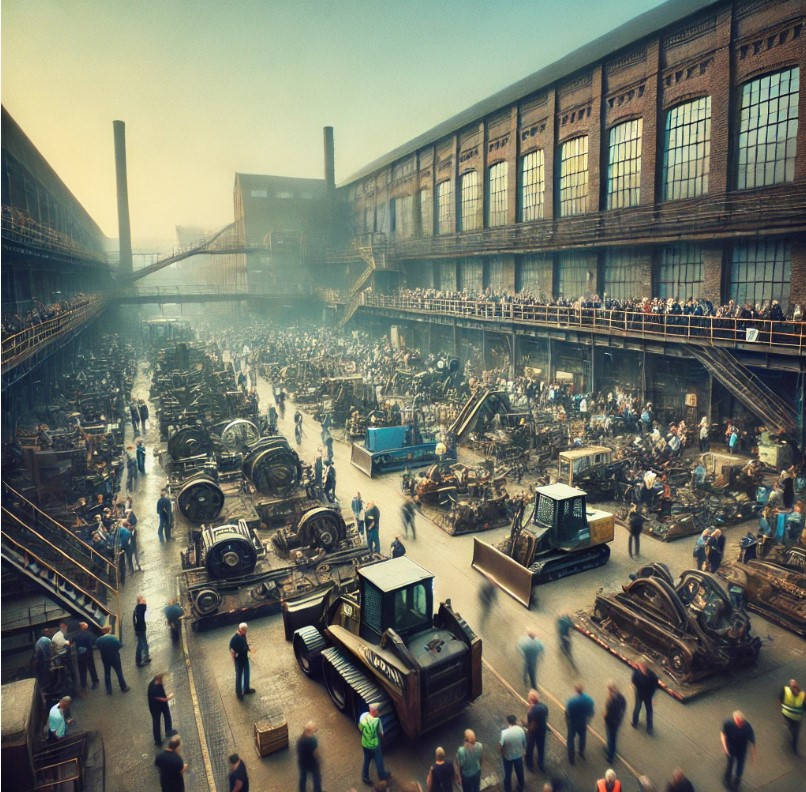Industrial auctions have been a cornerstone of the industrial machinery market for decades, providing businesses with an efficient means of acquiring or liquidating machinery and equipment. However, like many sectors, industrial auctions have undergone significant changes since the 1990s, evolving from traditional, in-person events to the digital, online platforms we see today. This shift has transformed the way businesses buy and sell industrial machinery, offering numerous advantages but also introducing new challenges.

In this article, we’ll explore the basics of industrial auctions, including key concepts such as reserve prices, the bidding process, compliance, and the commitment to bids. We’ll also delve into the transition from physical auctions to online auctions, examining the factors that drove this change and its impact on the industry.
1. Understanding Industrial Auctions
Before we dive into the evolution of industrial auctions, it’s essential to understand the basic principles that underpin these events.
1.1. What Are Industrial Auctions?
Industrial auctions are public sales where machinery, equipment, and other industrial assets are sold to the highest bidder. These auctions can feature a wide range of items, from heavy machinery like CNC machines and industrial robots to smaller tools and equipment. Auctions are often organized by companies looking to liquidate surplus assets, close down operations, or restructure their business.
1.2. Key Concepts in Industrial Auctions
Several fundamental concepts are integral to understanding how industrial auctions work:
- Reserve Price: The reserve price is the minimum amount that the seller is willing to accept for an item. If bidding does not reach this price, the item will not be sold. This ensures that sellers do not have to part with their assets at a price below their expectations.
- Bidding Process: The bidding process is the core of any auction. Participants place bids on items, with the highest bid at the end of the auction winning the item. In some cases, auctions may allow for pre-bidding, where participants can place bids before the auction begins.
- Compliance and Commitment to Bids: Compliance in industrial auctions refers to the requirement that all bids placed are legally binding. When a bid is placed, the bidder is committing to purchasing the item if they win, and failure to do so can result in legal consequences or penalties.
2. The Era of Physical Industrial Auctions
2.1. The Dominance of Physical Auctions in the 20th Century
Before the advent of the internet, industrial auctions were almost exclusively physical events. These auctions were typically held at a designated location, such as a warehouse, factory, or auction house. Buyers and sellers would gather in person to inspect the items, engage in bidding, and complete transactions.
Physical auctions were often day-long events, drawing participants from across the region or even internationally. The auctioneer played a crucial role, guiding the bidding process and ensuring that the auction ran smoothly. For many companies, these events were a key opportunity to acquire high-quality machinery at competitive prices or to sell off surplus equipment quickly.
2.2. Limitations of Physical Auctions
While physical auctions had their advantages, they also had several limitations:
- Geographical Constraints: Attending a physical auction required participants to be present at the auction site, which could be inconvenient or impractical for those located far away.
- Limited Audience: The pool of potential buyers was often limited to those who could attend the auction in person, potentially reducing competition and, by extension, the final sale prices.
- Time-Consuming Process: Organizing and attending physical auctions required significant time and effort. For buyers, this meant time away from their business, and for sellers, it often meant a slower process of liquidating assets.
3. The Rise of Online Industrial Auctions
3.1. The Internet Revolution of the 1990s
The 1990s saw the rapid expansion of the internet, which began to reshape various industries, including auctions. The possibility of conducting auctions online opened up new opportunities for buyers and sellers alike.
One of the first significant shifts in the auction industry was the rise of online auction platforms like eBay, which, although more consumer-focused, demonstrated the potential of online auctions. This success laid the groundwork for the development of specialized platforms for industrial machinery.

3.2. The Transition to Online Auctions
By the late 1990s and early 2000s, more auction houses and industrial machinery dealers began to explore the potential of online auctions. Initially, many of these auctions were hybrid events, combining physical and online elements. For example, a physical auction might be live-streamed, allowing remote bidders to participate in real-time.
However, as internet technology improved and trust in online transactions grew, fully online auctions began to gain popularity. Platforms such as BidSpotter, Proxibid, and Go-Dove emerged, offering dedicated spaces for industrial auctions.
3.3. Advantages of Online Auctions
The move to online auctions brought several significant advantages:
- Global Reach: Online auctions eliminated geographical barriers, allowing buyers from all over the world to participate. This increased competition, often resulting in higher final bids and better outcomes for sellers.
- Convenience: Buyers could participate in auctions from the comfort of their office or home, saving time and reducing travel expenses. Sellers, too, could reach a broader audience without the need to organize a physical event.
- Extended Bidding: Many online auctions introduced the concept of extended bidding, where the auction remains open for a set period after the last bid. This prevents last-second bidding (or “sniping”) and ensures a fairer outcome.
4. Key Elements of Online Industrial Auctions
While online auctions share many similarities with physical auctions, there are some unique aspects and considerations.
4.1. Setting Reserve Prices Online
In online auctions, the concept of a reserve price remains critical. Sellers set a minimum acceptable price to ensure they do not sell their assets below market value. Online platforms often allow sellers to set these prices privately, ensuring that the reserve price is not visible to potential buyers. This strategy can sometimes encourage more aggressive bidding, as participants are not aware of the price threshold they need to surpass.
4.2. The Bidding Process in Online Auctions
Online auctions typically operate on a timed basis, where each auction lasts for a predetermined period. Bidders can place bids at any time during this period, with the highest bid at the end of the auction winning the item. Some platforms also offer proxy bidding, where participants set a maximum bid, and the system automatically increases their bid in response to competing bids, up to their limit.
4.3. Compliance and Commitment in the Digital Space
One of the challenges of online auctions is ensuring compliance and commitment to bids. Since participants are not physically present, platforms must implement strict rules and verification processes to ensure that all bids are binding. Many platforms require bidders to register and provide financial guarantees before participating, reducing the risk of non-payment or bid withdrawal.
5. The Impact of Online Auctions on the Industrial Machinery Market
The shift to online auctions has had a profound impact on the industrial machinery market, influencing everything from pricing to market accessibility.
5.1. Increased Market Transparency
Online auctions have made the industrial machinery market more transparent. Buyers can now easily compare prices across different platforms and auctions, leading to a more informed purchasing process. This transparency has also helped standardize prices, as sellers must remain competitive to attract bidders.
5.2. Expanding the Buyer Base
The global reach of online auctions has expanded the buyer base for industrial machinery. Companies in emerging markets can now access high-quality equipment from around the world, leveling the playing field and promoting international trade.
5.3. Accelerating the Sales Process
Online auctions have also accelerated the sales process for industrial machinery. Sellers can quickly list their assets and reach a global audience, often resulting in faster sales than traditional methods. This speed is particularly beneficial for companies looking to quickly liquidate assets due to restructuring, downsizing, or bankruptcy.

6. Challenges and Considerations for Online Industrial Auctions
Despite the many advantages, online industrial auctions also present several challenges that both buyers and sellers must consider.
6.1. Trust and Verification
One of the primary concerns with online auctions is trust. Buyers may be hesitant to bid on high-value items without physically inspecting them. To address this, many online platforms offer detailed listings with photographs, videos, and third-party inspection reports. Some also provide guarantees or return policies to increase buyer confidence.
6.2. Shipping and Logistics
Another challenge is logistics. Unlike physical auctions, where buyers can often take immediate possession of their purchases, online auctions require coordination for shipping and delivery. Buyers must consider these additional costs and logistics when bidding on items located far from their business.
6.3. Legal and Compliance Issues
Compliance with local and international laws is crucial in online auctions, especially when dealing with cross-border transactions. Buyers and sellers must be aware of regulations regarding the export and import of industrial machinery, including any restrictions, taxes, or duties that may apply.
7. The Future of Industrial Auctions
The evolution of industrial auctions is far from over. As technology continues to advance, we can expect further innovations that will shape the future of this market.
7.1. Integration of Artificial Intelligence
Artificial Intelligence (AI) is likely to play a significant role in the future of online auctions. AI can be used to analyze bidding patterns, predict market trends, and even automate the bidding process for participants. This could lead to more efficient and competitive auctions, benefiting both buyers and sellers.
7.2. Blockchain for Enhanced Security
Blockchain technology could also enhance the security and transparency of online auctions. By creating a decentralized ledger of all transactions, blockchain can reduce the risk of fraud and ensure that all bids and payments are securely recorded.
7.3. Virtual and Augmented Reality
Virtual and augmented reality could transform the way buyers interact with auction items. Imagine being able to virtually “walk around” a piece of machinery, inspecting it from all angles before placing a bid. These technologies could bridge the gap between physical and online auctions, providing a more immersive and informative experience for buyers.
Conclusion
The transition from physical to online industrial auctions since the 1990s has revolutionized the way businesses buy and sell machinery. While the basic principles of auctions—such as reserve prices, bidding processes, and commitment to bids—remain the same, the shift to digital platforms has introduced greater convenience, accessibility, and transparency.
As the industry continues to evolve, we can expect further innovations that will continue to enhance the efficiency and effectiveness of industrial auctions. For businesses, staying informed about these developments and understanding how to navigate the online auction landscape will be key to capitalizing on the opportunities that these platforms offer.
FAQs
1. What is the main difference between physical and online industrial auctions?
The primary difference is that physical auctions require participants to be present at a specific location, while online auctions allow participants to bid from anywhere in the world via the internet.
2. How does a reserve price work in an online auction?
In an online auction, the reserve price is the minimum amount that the seller is willing to accept for an item. If bidding does not meet or exceed this price, the item will not be sold.
3. What are some advantages of online industrial auctions?
Online industrial auctions offer several advantages, including global reach, convenience, and often faster sales processes. They also provide greater transparency and a broader audience compared to physical auctions.
4. How do online auctions ensure that bids are binding?
Online auction platforms often require bidders to register and provide financial guarantees before participating. This ensures that all bids are legally binding and reduces the risk of non-payment.
5. What future technologies could impact online industrial auctions?
Future technologies such as Artificial Intelligence, blockchain, and virtual/augmented reality could significantly impact online industrial auctions by enhancing security, transparency, and the overall bidding experience.
Exapro’s “Exabids” Service: Enhancing Auction Efficiency
As the landscape of industrial auctions continues to evolve, Exapro has introduced a specialized service called Exabids to help factories and businesses organize and promote their auction sales with maximum efficiency. Through Exabids, Exapro partners with the most reputable auctioneers in the industry, carefully selecting the best fit for each auction based on the specific needs and type of machinery involved. But Exabids doesn’t stop there—Exapro also leverages its extensive global network to promote the auction, ensuring that it reaches a wide and relevant audience. This comprehensive approach maximizes the visibility of auctioned items, leading to more competitive bidding and better outcomes for sellers. Whether you’re looking to liquidate assets or acquire high-quality machinery, Exabids provides a streamlined, professional solution that connects sellers with the right buyers, optimizing the entire auction process.



